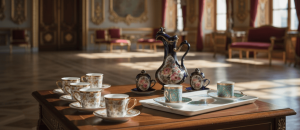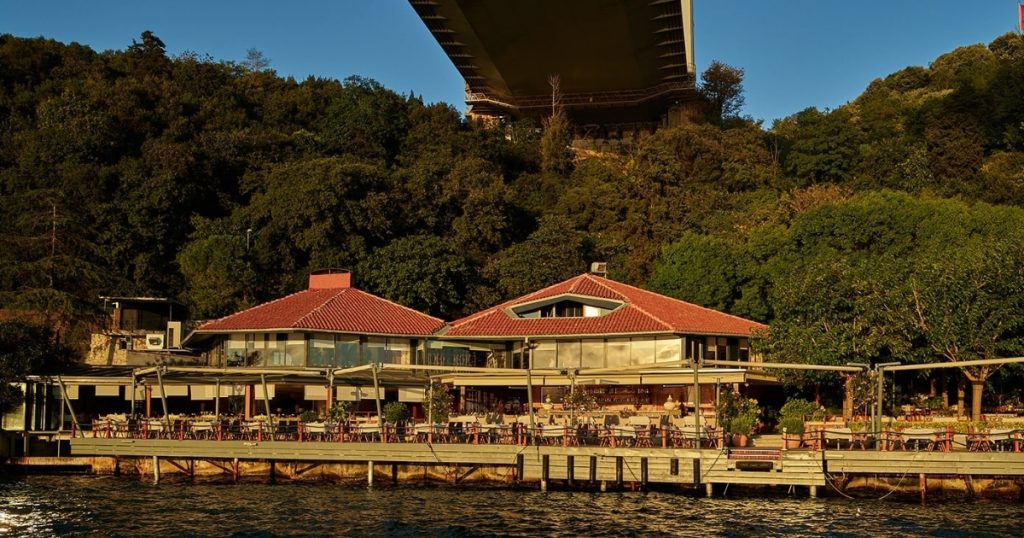The Sèvres porcelains and Baccarat crystal sets used in the diplomatic banquets of Dolmabahçe Palace were not merely luxurious dinner services, but also powerful cultural and political symbols that directly brought the aristocratic chic and elegance of Paris to the Sultan’s table. The use of these sets, along with the adoption of [Link: new table etiquette such as the use of cutlery -> /catal-bicak-sesleri-dolmabahce-sofrasi-osmanlinin-yuzyillik-yeme-aliskanliklarini-nasil-degistirdi], was a sophisticated message declaring that the Ottomans spoke the same “table language” as Europe’s highest diplomatic circles. Every plate and goblet was a silent diplomat saying, “We are also a European power like you”. [Link: Dolmabahçe Palace Collections -> /explore/palace-collections]
Why Sèvres and Baccarat? The Power of the Brand
In 19th-century Europe, the level of civilization and wealth of a palace or an aristocratic family was measured by the brand of porcelain used on its table. At the very top of this hierarchy were two French brands:
Sèvres Porcelain: The Sèvres Porcelain Factory, founded by the French royal family and owned by the state, was considered the pinnacle of porcelain artistry. Sèvres sets, which offered the finest examples of craftsmanship and were often decorated with rich colors like cobalt blue and pink, as well as gold gilding, were the ultimate status symbol that all royal families in Europe desired to possess.
Baccarat Crystal: Similarly, Baccarat was the most prestigious brand in crystal craftsmanship. With their flawless transparency, sharp cuts, and elegant designs, Baccarat goblets, carafes, and bowls were indispensable elements of a luxurious table.
The Ottoman Palace’s specific preference for these two brands stemmed from the desire to show that it demanded the best and had the power to acquire the best. This was not an ordinary purchase, but a conscious investment in prestige.
Tughra Elegance: The Language of Custom-Made Sets
The most striking feature of the Dolmabahçe Palace Sèvres and Baccarat collection is that most of the sets were specially commissioned for the Palace. The Ottoman tughra—the Sultan’s signature and the state’s emblem—was rendered onto these sets with gold gilding. This small yet extremely important detail completely altered the meaning of the sets:
Emphasis on National Identity: This meant the “nationalization” of a product acquired from Europe by striking it with the seal of Ottoman sovereignty. The Palace was not merely copying the luxury of the West; it was re-appropriating it by stamping it with its own identity.
Uniqueness and Prestige: A Sèvres plate or Baccarat goblet bearing a tughra was far more valuable and unique than a standard product sold on the market. This added an inimitable element of prestige, showing that it belonged solely to the Ottoman Palace.
Diplomatic Message: When a foreign ambassador dined from a Sèvres plate bearing the Sultan’s tughra, they experienced both the pinnacle of French civilization and the power of Ottoman sovereignty simultaneously. This was a subtle message emphasizing the synthesis of East and West and the Ottoman role as the host in this synthesis.
The Cultural Revolution at the Table
The introduction of these sets to the Dolmabahçe tables signified not just visual elegance, but also a cultural revolution. The communal dining arrangement, consisting of copper serving dishes and ceramic bowls from Topkapı Palace, was replaced by a personal set of dozens of pieces (main course plate, soup bowl, salad plate, dessert plate; water, wine, champagne goblets, etc.) laid out before each individual. This situation affected both the [Link: presentation of alafranga and alaturka dishes -> /padisahin-menusu-dolmabahce-mutfagindaki-alafranga-ve-alaturka-lezzetlerin-tatli-rekabeti] and made table etiquette more complex and ritualistic. The dining table was no longer merely a place to satisfy hunger, but a stage where social status, cultural knowledge, and elegance were displayed.
Conclusion
In conclusion, the collection of Sèvres porcelains and Baccarat crystal sets at Dolmabahçe Palace are the most important elements bringing the elegance of the Sultan’s table and Parisian chic to Istanbul. However, this collection signifies far more than simple luxury consumption. With the Ottoman tughras inscribed upon them, these sets are the cultural and diplomatic manifesto of a self-confident empire, combining the West’s most prestigious brands with its own symbols of sovereignty. They are invaluable historical documents that narrate the Ottoman Empire’s place in the modern world in the most stylish and most fragile manner.



















